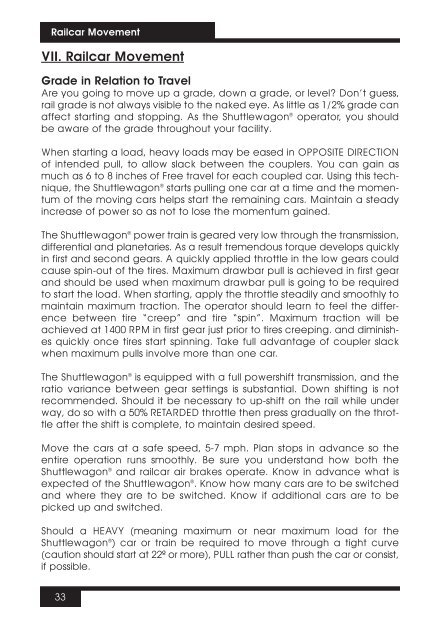SWX â€B†Series Operator's Manual - Shuttlewagon mobile railcar ...
SWX â€B†Series Operator's Manual - Shuttlewagon mobile railcar ...
SWX â€B†Series Operator's Manual - Shuttlewagon mobile railcar ...
You also want an ePaper? Increase the reach of your titles
YUMPU automatically turns print PDFs into web optimized ePapers that Google loves.
Railcar Movement<br />
VII. Railcar Movement<br />
Grade in Relation to Travel<br />
Are you going to move up a grade, down a grade, or level? Don’t guess,<br />
rail grade is not always visible to the naked eye. As little as 1/2% grade can<br />
affect starting and stopping. As the <strong>Shuttlewagon</strong> ® operator, you should<br />
be aware of the grade throughout your facility.<br />
When starting a load, heavy loads may be eased in OPPOSITE DIRECTION<br />
of intended pull, to allow slack between the couplers. You can gain as<br />
much as 6 to 8 inches of Free travel for each coupled car. Using this technique,<br />
the <strong>Shuttlewagon</strong> ® starts pulling one car at a time and the momentum<br />
of the moving cars helps start the remaining cars. Maintain a steady<br />
increase of power so as not to lose the momentum gained.<br />
The <strong>Shuttlewagon</strong> ® power train is geared very low through the transmission,<br />
differential and planetaries. As a result tremendous torque develops quickly<br />
in first and second gears. A quickly applied throttle in the low gears could<br />
cause spin-out of the tires. Maximum drawbar pull is achieved in first gear<br />
and should be used when maximum drawbar pull is going to be required<br />
to start the load. When starting, apply the throttle steadily and smoothly to<br />
maintain maximum traction. The operator should learn to feel the difference<br />
between tire “creep” and tire “spin”. Maximum traction will be<br />
achieved at 1400 RPM in first gear just prior to tires creeping. and diminishes<br />
quickly once tires start spinning. Take full advantage of coupler slack<br />
when maximum pulls involve more than one car.<br />
The <strong>Shuttlewagon</strong> ® is equipped with a full powershift transmission, and the<br />
ratio variance between gear settings is substantial. Down shifting is not<br />
recommended. Should it be necessary to up-shift on the rail while under<br />
way, do so with a 50% RETARDED throttle then press gradually on the throttle<br />
after the shift is complete, to maintain desired speed.<br />
Move the cars at a safe speed, 5-7 mph. Plan stops in advance so the<br />
entire operation runs smoothly. Be sure you understand how both the<br />
<strong>Shuttlewagon</strong> ® and <strong>railcar</strong> air brakes operate. Know in advance what is<br />
expected of the <strong>Shuttlewagon</strong> ® . Know how many cars are to be switched<br />
and where they are to be switched. Know if additional cars are to be<br />
picked up and switched.<br />
Should a HEAVY (meaning maximum or near maximum load for the<br />
<strong>Shuttlewagon</strong> ® ) car or train be required to move through a tight curve<br />
(caution should start at 22º or more), PULL rather than push the car or consist,<br />
if possible.<br />
33




